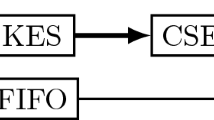Abstract
This paper proposes a high-speed and area-efficient three-parallel Reed-Solomon (RS) decoder using the simplified degree computationless modified Euclid (S-DCME) algorithm for the key equation solver (KES) block. To achieve a high throughput rate, the inner signals, such as the syndrome, error locator and error value polynomials, are computed in parallel. In addition, the key equations are solved by using the S-DCME algorithm to reduce the hardware complexity. To handle the many problems caused by applying the S-DCME algorithm to the KES block, we modify the architectures of some of the blocks in the three-parallel RS decoder. The proposed RS architecture can reduce the hardware complexity by about 80% with respect to the KES block. In addition, the proposed RS architecture has an approximately 25% shorter latency than the conventional parallel RS architectures.










Similar content being viewed by others
References
Raghupathy, A., & Liu, K. J. R. (2000). Algorithm-based low-power/high-speed Reed-Solomon decoder design. IEEE Transactions on Circuits and Systems. II, Analog and Digital Signal Processing, 47(11), 1254–1270.
Framing structure, channel coding and modulation for digital terrestrial television. European Telecommunications Standards Institute, DVB, Rep. No. ETSI EN 300 744 v1.4.1, 2001.
Michelson, A. M., & Levesque, A. H. (1985). Error-control techniques for digital communication. New York: Wiley.
Rao, T. R. N., & Fujiwara, E. (1989). Error control coding for computer systems. Englewood Cliff: Prentice-Hall.
Jeng, J. H., & Truong, T. K. (1999). On decoding of both errors and erasures of a Reed-Solomon code using an inverse-free Berlekamp-Massey algorithm. IEEE Transactions on Communications, 47, 1488–1494.
Sarwate, D. V., & Shanbhag, N. R. (2001). High-speed architectures for Reed-Solomon decoders. IEEE Transactions on Very Large Scale Integration (VLSI) Systems, 9, 641–655.
Ali, M. A. A., Abou-El-Azm, A., & Marie, M. F. (1999). Error rates for non-coherent demodulation FCMA with Reed-Solomon codes in fading satellite channel. In Proc. IEEE Vehicular Techn. Conf. (VTC 99), 1, 92–96.
Matsushima, T. K., Matsushima, T., & Hirasawa, S. (1998). Parallel architecture for high-speed Reed-Solomon codec. In Proc. IEEE Int. Telecommun. Symp. (ITS 98), vol. 2, pp. 468–473.
Lee, H. H., Yu, M. L. & Song, L. (2000) VLSI design of Reed-Solomon decoder architectures. In Proc. IEEE Int. Symp. Circuits Sysy. (ISCAS 2000), vol. 5, May 2000, pp 705–708.
Lee, H. H. (2001). Modified Euclidean algorithm block for high-speed Reed-Solomon decoder. IEE Electronics Letters, 37, 903–904.
Shao, H. M., Truog, T. K., Deutsch, L. J., Yuen, J. H., & Reed, I. S. (1985). A VLSI design of a pipeline Reed-Solomon decoder. IEEE Transactions on Computers, C-34, 393–403.
Baek, J. H., & Sunwoo, M. H. (2006). New degree computationless modified Euclid’s algorithm and architecture for Reed-Solomon decoder. IEEE Transactions on Very Large Scale Integration (VLSI) Systems, 14, 915–920.
Lee, H., Choi, C.-S., Shin, J., & Ko, J.-S. (2008). 100-Gb/s three-parallel reed-solomon based forward error correction architecture for optical communications. International SoC Design Conference, pp. 265–268, Nov. 24–25, 2008.
Lee, S., & Lee, H. (2008). A high-speed pipelined degree-computationless modified euclidean algorithm architecture for Reed-Solomon decoders. IEICE Transactions on Fundamentals of Electronics, Communications, and Computer Sciences, E91-A(3), 830–835.
Baek, J. H., & Sunwoo, M. H. (2007). Simplified degree computationless modified Euclid’s algorithm and its architecture. In Proc. IEEE Int. Symp. Circuits Sys. (ISCAS 2007), May 2007, pp 905–908.
Lee, H. (2003). High-speed VLSI architecture for parallel Reed-Solomon decoder. IEEE Transactions on Very Large Scale Integration (VLSI) Systems, 11(2), 288–294.
Baek, J. H., & Sunwoo, M. H. (2007). Enhanced degree computationless modified Euclid’s algorithm for Reed-Solomon decoders. Electronics Letters—IEEE, 43(2), 175–176.
Lee, S., Choi, C.-S., & Lee, H. (2008). Two-parallel Reed-Solomon based FEC architecture for optical communications. IEICE Electronics Express, 5(10), 374–380.
Acknowledgments
This work was supported in part by the IT R&D program of MKE/KEIT [KI002145, High Speed Digital Signal Processing based CMOS Circuit Design for Next-generation Optical Communication] and in part by IDEC (IC Design Education Center).
Author information
Authors and Affiliations
Corresponding author
Additional information
An erratum to this article can be found at http://dx.doi.org/10.1007/s11265-012-0659-5.
Rights and permissions
About this article
Cite this article
Lee, J.D., Sunwoo, M.H. Three-Parallel Reed-Solomon Decoder Using S-DCME for High-Speed Communications. J Sign Process Syst 66, 15–24 (2012). https://doi.org/10.1007/s11265-010-0517-2
Received:
Revised:
Accepted:
Published:
Issue Date:
DOI: https://doi.org/10.1007/s11265-010-0517-2




